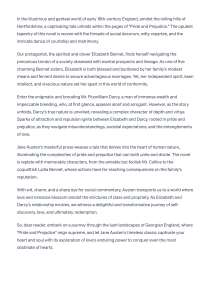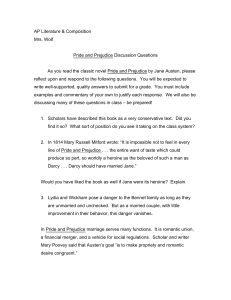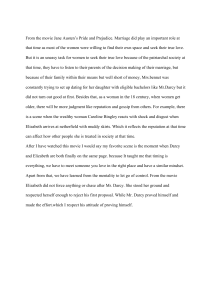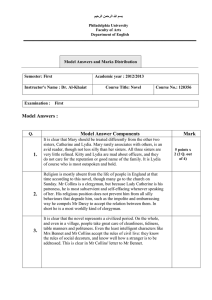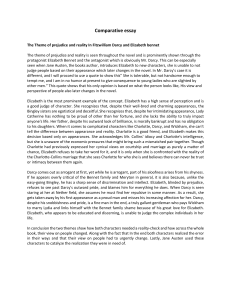Pride and Prejudice: Summary, Characters & Analysis | Britannica
advertisement
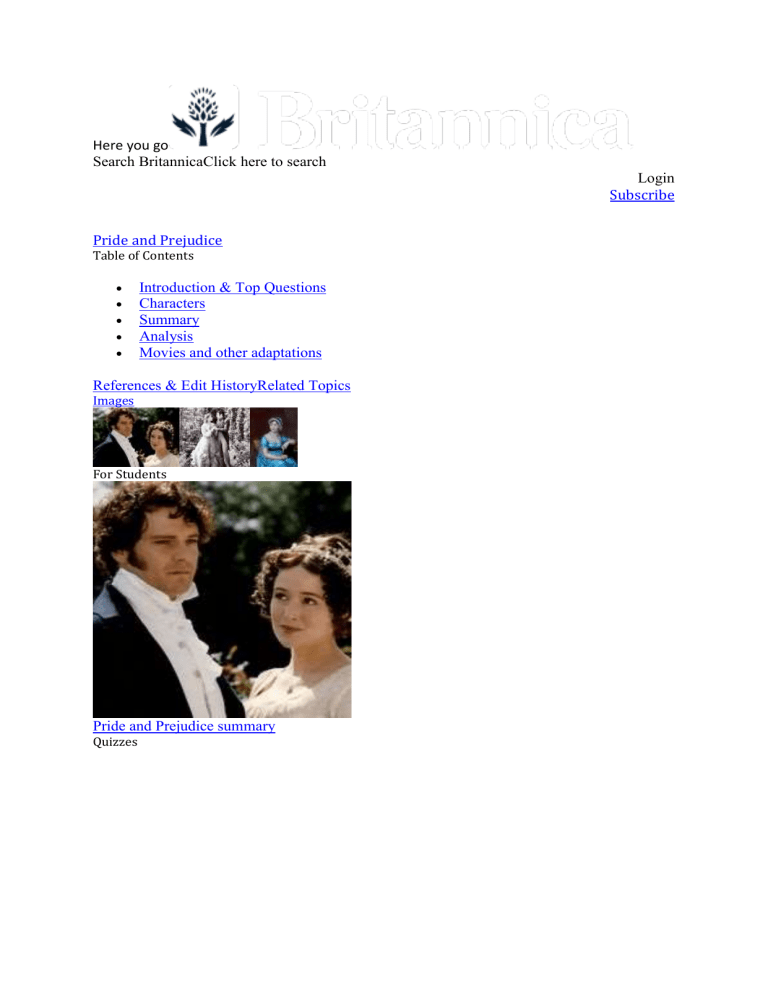
Here you go Search BritannicaClick here to search Login Subscribe HomeGames & QuizzesHistory & SocietyScience & TechBiographiesAnimals & NatureGeography & TravelArts & CultureMoneyVideos Pride and Prejudice Table of Contents Introduction & Top Questions Characters Summary Analysis Movies and other adaptations References & Edit HistoryRelated Topics Images For Students Pride and Prejudice summary Quizzes The Literary World (Famous Novels) Name the Novelist Famous Novels, First Lines Quiz Famous Novels, Last Lines Quiz Related Questions What did Jane Austen accomplish? What was Jane Austen’s family like? What did Jane Austen write? Read Next 12 Novels Considered the “Greatest Book Ever Written” Britannica’s Book Bingo 12 Novels Considered the “Greatest Book Ever Written” Britannica’s Book Bingo 10 Captivating Contemporary Novels Set in the British Isles Discover 9 Things You Might Not Know About Adolf Hitler Pablo Escobar: 8 Interesting Facts About the King of Cocaine Inventors and Inventions of the Industrial Revolution Flags That Look Alike The 10 Greatest Basketball Players of All Time 7 of History's Most Notorious Serial Killers Were the Nazis Socialists? HomeLiteratureNovels & Short Stories Arts & Culture Pride and Prejudice novel by Austen Print Cite Share Feedback Also known as: “First Impressions” Written by Sarah Dillon Fact-checked by The Editors of Encyclopaedia Britannica Article History Top Questions What is Pride and Prejudice? Who is the author of Pride and Prejudice? What is the plot of Pride and Prejudice? What is the first sentence of Pride and Prejudice? What was Pride and Prejudice originally titled? Colin Firth and Jennifer Ehle in Pride and Prejudice Colin Firth and Jennifer Ehle in the TV miniseries Pride and Prejudice (1995). Pride and Prejudice, romantic novel by Jane Austen, published anonymously in three volumes in 1813. A classic of English literature, written with incisive wit and superb character delineation, it centres on the burgeoning relationship between Elizabeth Bennet, the daughter of a country gentleman, and Fitzwilliam Darcy, a rich aristocratic landowner. Upon publication, Pride and Prejudice was well received by critics and readers. The first edition sold out within the first year, and it never went out of print. Characters Pride and Prejudice is set in rural England at the turn of the 19th century, and it follows the Bennet family, which includes five very different sisters. The eldest, Jane, is sweet-tempered and modest. She is her sister Elizabeth’s confidant and friend. Elizabeth, the heroine of the novel, is intelligent and high-spirited. She shares her father’s distaste for the conventional views of society as to the importance of wealth and rank. The third daughter, Mary, is plain, bookish, and pompous, while Lydia and Kitty, the two youngest, are flighty and immature. Mr. Bennet is the family patriarch. He is fond of his two eldest daughters—especially his favourite, Elizabeth—but takes a passive interest in the younger ones, ultimately failing to curb their childish instincts. An intelligent but eccentric and sarcastic man, he does not care for society’s conventions and mocks his wife’s obsession with finding suitable husbands for their daughters. As several scholars have noted, however, Mrs. Bennet is rightfully concerned. Because of an entail, the modest family estate is to be inherited by William Collins, Mr. Bennet’s nephew, who is the next male in line. Indeed, as Austen scholar Mary Evans noted, “If Mrs. Bennett is slightly crazy, then perhaps she is so because she perceives more clearly than her husband the possible fate of her five daughters if they do not marry.” Unfortunately, Mrs. Bennet’s fervour and indelicacy often work against her interests. A woman of little sense and much self-pity, she indulges her lively youngest daughters. Throughout the novel, the Bennet sisters encounter several eligible bachelors, including Charles Bingley, Darcy, Lieutenant George Wickham, and Collins. Bingley has recently let Netherfield estate, which neighbours the Bennets’ home, Longbourn. Austen describes him as “good-looking and gentlemanlike; [having] a pleasant countenance and easy, unaffected manners.” He has come by his fortune through his family’s interest in trade, which was seen as a less respectable means of obtaining wealth than by inheriting it, as his friend Darcy has done. Darcy is clearly a product of this hierarchical thinking: he believes in the natural superiority of the wealthy landed gentry. He is arrogant but perceptive. Britannica Quiz Famous Novels, First Lines Quiz Darcy’s estates were once managed by Wickham’s father, but he and Wickham are no longer friendly. Wickham is attractive and charming, making him immediately popular among the women in the nearby town of Meryton, where he and other soldiers have been stationed. Collins, on the other hand, is “not a sensible man, and the deficiency of nature had been but little assisted by education or society.” He is a clergyman whose patron, the controlling Lady Catherine de Bourgh, is Darcy’s aunt. Other supporting characters in the novel include Elizabeth’s friend Charlotte Lucas, who is described as sensible and nearing an age where marriage is unlikely; Charlotte’s parents, Sir William and Lady Lucas; Mrs. Bennet’s brother, Edward Gardiner, who works in trade, and his wife, both of whom are generous and wellgrounded; Bingley’s sisters, the snobbish and scheming Caroline and Louisa Hurst; and Darcy’s 16-year-old sister, Georgiana, who is painfully shy but good-humoured. Get a Britannica Premium subscription and gain access to exclusive content.Subscribe Now Summary Greer Garson and Laurence Olivier in Pride and Prejudice Greer Garson and Laurence Olivier in Pride and Prejudice (1940), directed by Robert Z. Leonard.(more) The novel opens with one of the most famous lines in English literature: “It is a truth universally acknowledged, that a single man in possession of a good fortune, must be in want of a wife.” The statement is seemingly what Mrs. Bennet thinks as she sets her sights on the newly arrived Bingley, who she is sure will make a suitable husband for one of her daughters. At a ball, Bingley takes an immediate interest in the beautiful and shy Jane. The encounter between his friend Darcy and Elizabeth is less cordial. Although Austen shows them intrigued by each other, she reverses the convention of first impressions: the pride of rank and fortune and prejudice against the social inferiority of Elizabeth’s family hold Darcy aloof, while the pride of selfrespect and prejudice against Darcy’s snobbery hold Elizabeth equally aloof. The pompous Collins soon arrives, hoping to marry one of the Bennet sisters. Mrs. Bennet steers him toward Elizabeth, but the latter refuses his offer of marriage. He instead becomes engaged to her friend Charlotte. During this time, Elizabeth encounters the charming Wickham. There is a mutual attraction between the two, and he informs her that Darcy has denied him his inheritance. After Bingley abruptly departs for London, Elizabeth’s dislike of Darcy mounts as she becomes convinced that he is discouraging Bingley’s relationship with Jane. Darcy, however, has grown increasingly fond of Elizabeth, admiring her intelligence and vitality. While visiting the now-married Charlotte, Elizabeth sees Darcy, who professes his love for her and proposes. A surprised Elizabeth refuses his offer, and, when Darcy demands an explanation, she accuses him of breaking up Jane and Bingley and of denying Wickham his inheritance. Darcy subsequently writes Elizabeth a letter in which he explains that he separated the couple largely because he did not believe Jane returned Bingley’s affection. He also discloses that Wickham, after squandering his inheritance, tried to marry Darcy’s then 15-year-old sister in an attempt to gain possession of her fortune. With these revelations, Elizabeth begins to see Darcy in a new light. Shortly thereafter the youngest Bennet sister, Lydia, elopes with Wickham. The news is met with great alarm by Elizabeth, since the scandalous affair—which is unlikely to end in marriage—could ruin the reputation of the other Bennet sisters. When she tells Darcy, he persuades Wickham to marry Lydia, offering him money. Despite Darcy’s attempt to keep his intervention a secret, Elizabeth learns of his actions. At the encouragement of Darcy, Bingley subsequently returns, and he and Jane become engaged. Finally, Darcy proposes again to Elizabeth, who this time accepts. Analysis Jane Austen The work, which Austen initially titled First Impressions, is the second of four novels that Austen published during her lifetime. Although Pride and Prejudice has been criticized for its lack of historical context (it is likely set either during the French Revolution [1787–99] or the Napoleonic Wars [1799–1815]), the existence of its characters in a social bubble that is rarely penetrated by events beyond it is an accurate portrayal of the enclosed social world in which Austen lived. She depicted that world, in all its own narrow pride and prejudice, with unswerving accuracy and satire. At the same time, she placed at its centre, as both its prime actor and most perceptive critic, a character so well conceived and rendered that the reader cannot but be gripped by her story and wish for its happy denouement. In the end, Austen’s novel has remained popular largely because of Elizabeth—who was reportedly Austen’s own favourite among all her heroines—and because of the enduring appeal to men and women alike of a well-told and potentially happily ending love story. Movies and other adaptations Pride and Prejudice inspired various stage, film, and television productions. Notable adaptations included the 1940 film with Greer Garson as Elizabeth and Laurence Olivier as Darcy, the 1995 TV miniseries starring Jennifer Ehle and Colin Firth, and the 2005 movie featuring Keira Knightley and Matthew Macfadyen. The novel also served as a premise for a myriad of books at the turn of the 21st century, including the best seller Bridget Jones’s Diary (1996) by Helen Fielding (which was followed by a number of sequels and adapted into a popular movie series [2001–16] starring Renée Zellweger, Firth, and Hugh Grant). Other such books included Pride and Prejudice and Zombies (2009) by Seth GrahameSmith (also adapted into a movie [2016]) and Sofia Khan Is Not Obliged (2015) by Ayisha Malik, in which a 21st-century Muslim woman is intrigued by her sullen tattooed neighbour. These interpretations showed the universal and enduring appeal of Pride and Prejudice and its themes. Sarah DillonThe Editors of Encyclopaedia Britannica Fitzwilliam Darcy Table of Contents IntroductionReferences & Edit History Quizzes The Literary World (Characters Quiz) Pop Culture Quiz Related Questions What did Jane Austen accomplish? What was Jane Austen’s family like? What did Jane Austen write? Read Next 12 Novels Considered the “Greatest Book Ever Written” Britannica’s Book Bingo Discover Why Is Black History Month Celebrated in February? How Did Alexander the Great Really Die? Pablo Escobar: 8 Interesting Facts About the King of Cocaine Do We Really Use Only 10 Percent of Our Brain? Timeline of the American Civil Rights Movement Timeline of the American Revolution What Is the Origin of the Term Holocaust? HomeLiteratureFictional Characters Arts & Culture Fitzwilliam Darcy fictional character Print Cite Share Feedback Written and fact-checked by The Editors of Encyclopaedia Britannica Last Updated: Jan 13, 2024 • Article History Recent News Jan. 12, 2024, 12:54 AM ET (Yahoo News) Sunnei to Endorse Lessico Familiare in Milan Fashion Week ... Fitzwilliam Darcy, fictional character, the suitor of Elizabeth Bennet in the novel Pride and Prejudice (1813) by Jane Austen. At first Elizabeth spurns him because of his extreme pride, but when Darcy and Elizabeth come to know one another, his true character is revealed. This article was most recently revised and updated by Kathleen Kuiper.
